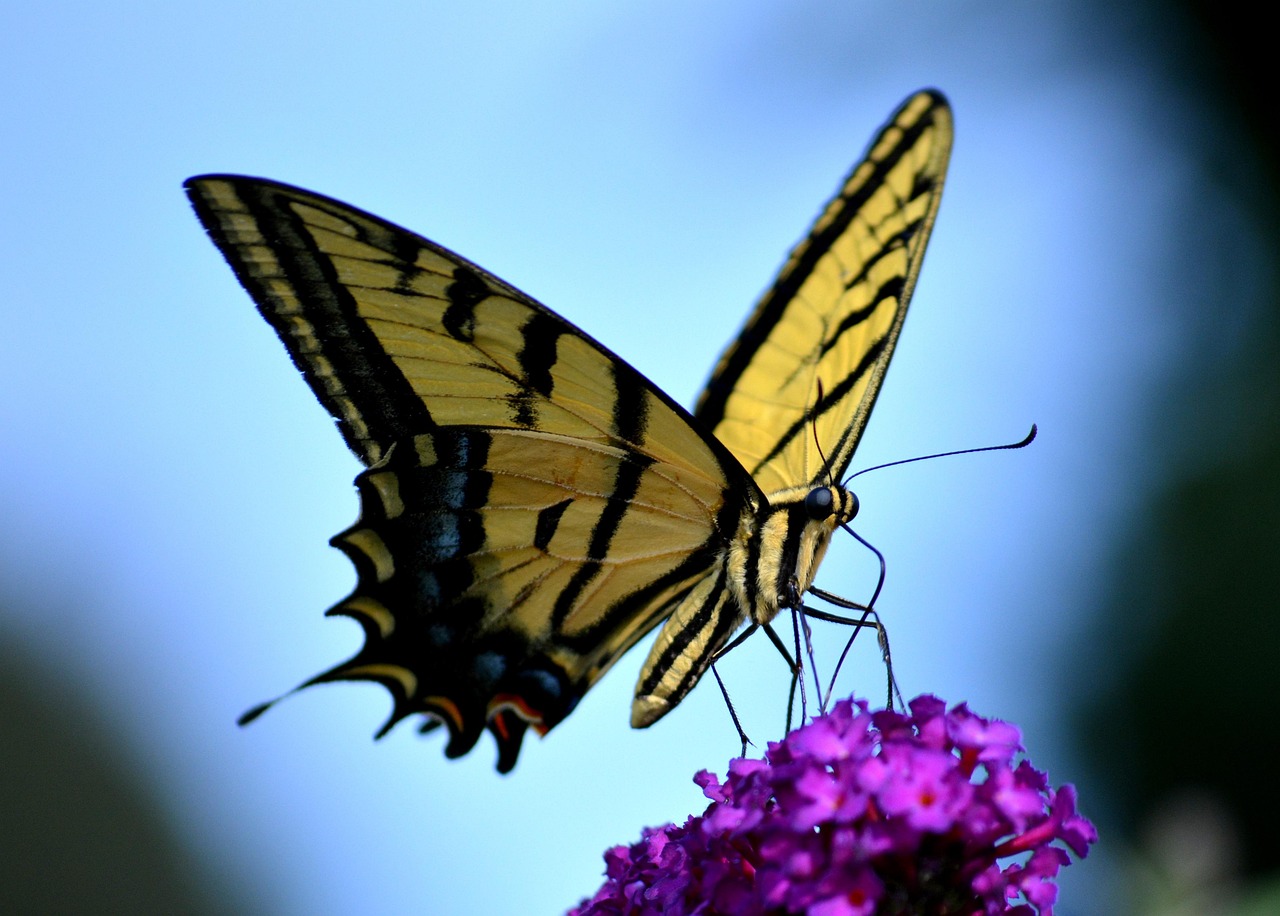Tiger swallowtails are best found in open woodlands, meadows, and near water sources such as rivers and lakes. The ideal times to observe them are during the warm months of spring and summer, particularly from late morning to early afternoon when they actively feed on nectar from flowers.
Understanding Tiger Swallowtails

Tiger swallowtails, scientifically known as Papilio machaon, are among the most recognizable butterflies in North America. Their striking yellow and black patterned wings make them a favorite among butterfly enthusiasts and nature lovers alike. These butterflies are not only beautiful but also play an essential role in pollination, contributing to the health of various ecosystems.
Tiger swallowtails have a wide distribution across the continent, thriving in various habitats. Their adaptability allows them to inhabit areas ranging from urban gardens to wild landscapes. Understanding where and when to find them can enhance your chances of witnessing these magnificent creatures up close.
Habitat Preferences
To effectively locate tiger swallowtails, it is crucial to understand their habitat preferences. They are commonly found in areas that provide ample food sources and suitable places for reproduction. Here are some key habitat characteristics that attract tiger swallowtails:
- Open woodlands with abundant wildflowers
- Meadows that feature a variety of flowering plants
- Riparian zones near rivers and lakes
- Parks and gardens with nectar-rich flowers
The presence of host plants is also vital for the survival of tiger swallowtail caterpillars. Trees such as willows, cottonwoods, and tulip poplars serve as essential food sources for the larvae during their growth phase.
Best Times to Observe
The timing of your observations can significantly influence your chances of seeing tiger swallowtails. They are most active during specific seasons and times of the day:
| Season | Best Times for Observation |
|---|---|
| Spring | Late morning to early afternoon |
| Summer | Midday when temperatures are warmest |
During spring, you may begin to spot tiger swallowtails emerging as they search for food sources after hibernation. In summer, their activity peaks, making it the prime season for butterfly watching. Observing them during the warmest parts of the day allows you to witness their feeding behavior as they flutter from flower to flower.
To maximize your chances of seeing these butterflies, consider visiting locations known for vibrant wildflower displays. Local nature reserves, botanical gardens, and well-maintained parks often provide excellent opportunities for observation. Be sure to bring along a camera or binoculars for an up-close view of their beauty.
Identifying Tiger Swallowtails
Spotting a tiger swallowtail in the wild can be an exhilarating experience. However, to truly appreciate their beauty and behavior, it is essential to learn how to identify these butterflies accurately. Their distinctive features set them apart from other species.
Physical Characteristics
Tiger swallowtails are renowned for their vibrant coloration and unique wing patterns. Here are some key physical characteristics:
- Wingspan: Adults typically have a wingspan of 3 to 5 inches.
- Coloration: The forewings are predominantly yellow with bold black stripes resembling tiger stripes, while the hindwings are yellow with a row of blue and orange spots.
- Sexual Dimorphism: Female tiger swallowtails exhibit a darker coloration than males, often appearing almost black due to the presence of additional dark pigments.
Understanding these traits can help you correctly identify tiger swallowtails in various habitats. They often flutter gracefully through meadows and gardens, making them a delightful sight for nature enthusiasts.
Attracting Tiger Swallowtails to Your Garden
If you are interested in observing tiger swallowtails up close, creating a butterfly-friendly garden is an excellent way to attract them. Here are some tips on how to design a space that will entice these beautiful butterflies:
Selecting the Right Plants
Choosing the appropriate plants is crucial for attracting tiger swallowtails. The following plants are particularly appealing:
- Nectar Plants: Plant a variety of nectar-rich flowers like coneflowers, black-eyed Susans, and milkweed to provide food sources.
- Host Plants: Include host plants such as tulip poplars, willows, and sweet bay magnolia. These plants are essential for laying eggs and providing food for caterpillars.
- Native Species: Incorporate native flowering plants, as they often attract more butterflies and support local ecosystems.
By cultivating a diverse selection of plants, you can create an inviting environment for tiger swallowtails and other pollinators.
Creating a Suitable Environment
A butterfly garden should offer more than just food. Consider these elements to enhance the habitat:
- Sunlight: Ensure your garden receives plenty of sunlight, as butterflies thrive in warm, sunny conditions.
- Shelter: Provide shelter through shrubs or small trees where butterflies can rest and seek refuge from predators.
- Water Sources: Incorporate shallow water sources like birdbaths or mud puddles, as butterflies require hydration.
By creating a balanced ecosystem in your garden, you can enjoy watching tiger swallowtails and other butterflies throughout the active months.
Observing Behavior
Understanding the behavior of tiger swallowtails can enhance your observation experience. Here are some notable behaviors to watch for:
Feeding Habits
Tiger swallowtails primarily feed on nectar from flowers. They use their long proboscis to extract nectar from deep flowers. Watch for them hovering around:
- Butterfly Bushes: These plants are particularly attractive due to their dense clusters of flowers.
- Lantanas: Known for their vibrant colors, lantanas are a favorite among many butterfly species.
- Zinnias: These hardy flowers provide abundant nectar and come in various colors.
During feeding, you may notice their characteristic fluttering as they move from flower to flower, showcasing their vibrant coloration against the backdrop of blooming plants.
Mating Rituals
Mating behavior is another interesting aspect of tiger swallowtail life. Male butterflies often engage in territorial displays to attract females. They may be seen flying high above their chosen territory or chasing off rivals. Observing these interactions can provide insight into their reproductive habits and social structures.
By familiarizing yourself with these behaviors and characteristics, you will deepen your appreciation for tiger swallowtails and increase your chances of successful observation in the wild or at home.
Conservation and Threats to Tiger Swallowtails

Tiger swallowtails are not only beautiful creatures but also vital components of their ecosystems. However, like many butterfly species, they face various threats that can impact their populations. Understanding these challenges is crucial for their conservation.
Habitat Loss
One of the most significant threats to tiger swallowtails is habitat loss. Urban development, agricultural expansion, and deforestation reduce the natural areas where these butterflies thrive. As their habitats decline, so do their chances of survival. Here are some key factors contributing to habitat loss:

- Urbanization: Expansion of cities leads to the destruction of open spaces and natural landscapes.
- Agriculture: Pesticides and monoculture farming practices can eliminate the diverse plant life that supports butterfly populations.
- Climate Change: Changing weather patterns can disrupt the ecosystems that sustain tiger swallowtails, affecting their food sources and breeding grounds.
Conservation efforts aim to protect and restore natural habitats to ensure that tiger swallowtails have suitable environments in which to live and reproduce.
Pesticide Use
The use of pesticides in agricultural and gardening practices poses another significant threat to tiger swallowtails. These chemicals can be harmful not only to the targeted pests but also to beneficial insects like butterflies. Here are some impacts of pesticide use:
- Direct Toxicity: Pesticides can kill butterflies upon contact or ingestion, leading to population declines.
- Disruption of Feeding: Chemicals may reduce the availability of nectar-rich flowers that attract butterflies.
- Impact on Larvae: Pesticides can affect caterpillars feeding on host plants, reducing their survival rates.
Promoting organic gardening practices and minimizing pesticide use can help create safer environments for tiger swallowtails and other pollinators.
How to Help Conserve Tiger Swallowtails
As individuals, there are several ways to contribute to the conservation of tiger swallowtails and other butterfly species. Simple actions can have a significant impact on their populations.
Create Butterfly-Friendly Habitats
As previously mentioned, establishing butterfly gardens is one effective way to support tiger swallowtails. Here are a few additional tips for creating a sustainable environment:
- Plant Native Flora: Focus on native plants that are adapted to your region. They provide essential food sources for butterflies and help maintain local biodiversity.
- Avoid Chemical Treatments: Opt for natural pest control methods instead of chemical pesticides to protect butterflies.
- Provide Shelter: Create sheltered areas in your garden using shrubs or small trees where butterflies can rest and hide from predators.
Participate in Citizen Science
Engaging in citizen science projects can contribute valuable data to researchers studying butterfly populations. Consider the following activities:
- Butterfly Counts: Join local butterfly counts or surveys to help track population changes over time.
- Reporting Sightings: Share your observations with local conservation groups or online platforms dedicated to butterfly monitoring.
- Educational Outreach: Encourage friends and family to participate in butterfly conservation efforts by sharing information and resources.
Your involvement can help increase awareness about the importance of preserving tiger swallowtails and their habitats.
The Role of Education in Conservation
Education is a powerful tool in promoting conservation efforts. Understanding the ecological significance of tiger swallowtails and other butterflies fosters a deeper appreciation for nature. Here are some educational initiatives that can make a difference:
- Workshops and Seminars: Attend or organize events focusing on butterfly identification, gardening for pollinators, and conservation strategies.
- School Programs: Encourage schools to incorporate butterfly studies into their curriculum, allowing students to learn about ecosystems and the importance of biodiversity.
- Community Involvement: Collaborate with local organizations to host community events centered around butterfly conservation, such as clean-up days or planting projects.
By fostering a sense of stewardship for the environment, we can inspire future generations to protect these beautiful creatures and their habitats.
Monitoring Local Populations

In addition to engaging in community education and outreach, monitoring local tiger swallowtail populations can provide essential data for conservation efforts. By tracking changes in their numbers and distribution, we can better understand the effects of environmental changes and conservation strategies.
Setting Up Monitoring Programs
Establishing a local monitoring program can be an effective way to contribute valuable information to butterfly research. Here are some steps to consider:
- Choose Observation Sites: Identify key locations where tiger swallowtails are frequently seen, such as parks, nature reserves, or botanical gardens.
- Regular Surveys: Conduct regular butterfly counts during peak activity seasons. This could be done weekly or biweekly, depending on your schedule and resources.
- Record Data: Maintain detailed records of sightings, including dates, locations, weather conditions, and the number of individuals observed. This data can be shared with local conservation groups or used for personal research.
By systematically collecting data, you can contribute to a larger understanding of tiger swallowtail health and trends in your area.
Engaging with Online Platforms
Utilizing online platforms can enhance your monitoring efforts. Many websites and applications allow users to report butterfly sightings and contribute to citizen science initiatives. Some popular platforms include:
- iNaturalist: A community of naturalists sharing observations and helping with species identification.
- Butterfly Conservation: Organizations that focus on butterfly conservation often have dedicated reporting systems for sightings.
- eButterfly: A platform specifically designed for butterfly enthusiasts to log their observations and contribute to research.
Participating in these platforms not only helps document tiger swallowtail populations but also connects you with a network of like-minded individuals who share a passion for butterflies.
Exploring Tiger Swallowtails in Different Regions
Tiger swallowtails are found in various habitats across North America, each presenting unique viewing opportunities. Exploring different regions can provide insight into how these butterflies adapt to diverse environments. Here are a few notable regions to consider:
Eastern United States
The eastern U.S. is home to the eastern tiger swallowtail, which thrives in decaying woodlands, gardens, and suburban areas. Observers can find these butterflies flitting among wildflowers in spring and summer, particularly near water sources.
Western United States
The western tiger swallowtail differs slightly in appearance and habitat preferences. Found in mountainous regions and forested areas, they are often seen near rivers and streams. Their activity peaks during warmer months, making late spring and summer ideal for viewing.
Urban Environments
Interestingly, tiger swallowtails can also adapt to urban areas, where gardens and parks provide vital resources. Urban gardeners can play a significant role in supporting these butterflies by planting native species and creating green spaces.
Final Thoughts
Finding tiger swallowtails in their preferred habitats and understanding the best times for observation enhances the joy of butterfly watching. By recognizing their habitat needs, engaging in conservation efforts, and participating in community education, we can help ensure the survival of these exquisite butterflies for generations to come.
The beauty of tiger swallowtails serves as a reminder of the intricate relationships within our ecosystems. By fostering an appreciation for these butterflies, we encourage a greater commitment to preserving their habitats and promoting biodiversity. Whether you are an avid butterfly enthusiast or a casual observer, your efforts to support tiger swallowtails are invaluable.
As you explore gardens, parks, and natural areas this spring and summer, take a moment to observe the graceful flight of tiger swallowtails. Your passion for these magnificent creatures contributes to their conservation and enriches our natural world.
